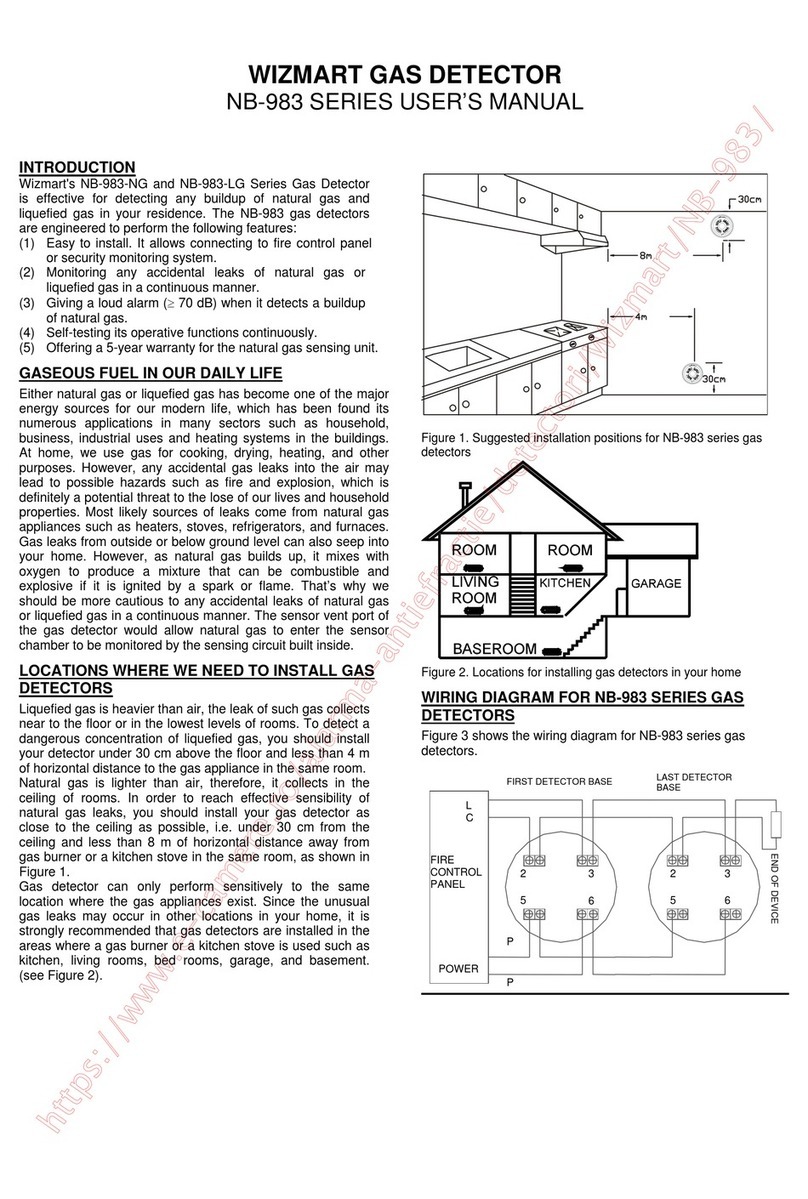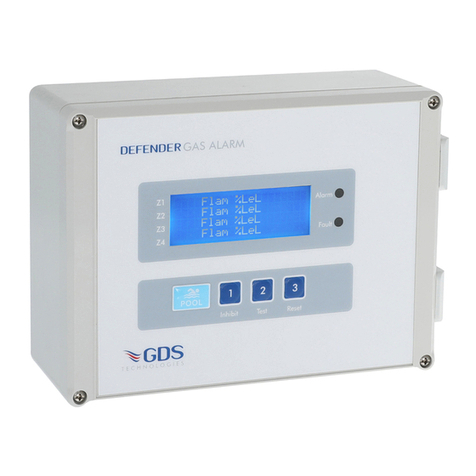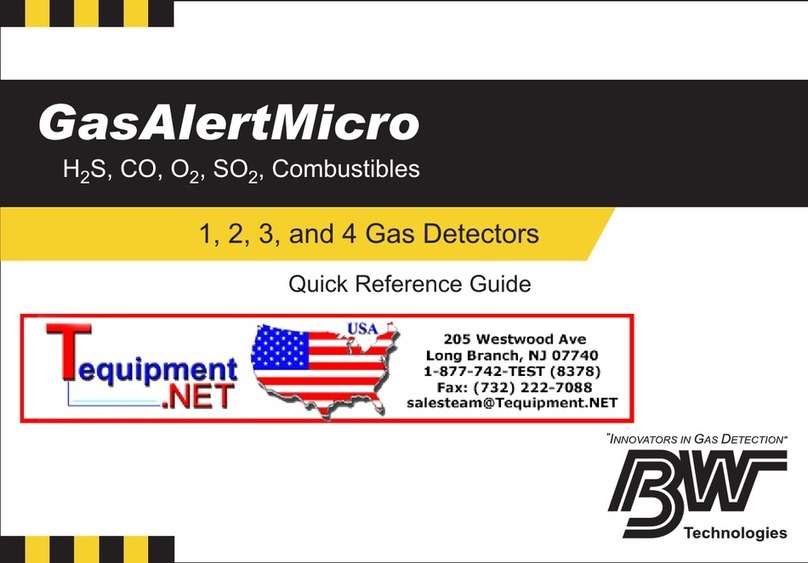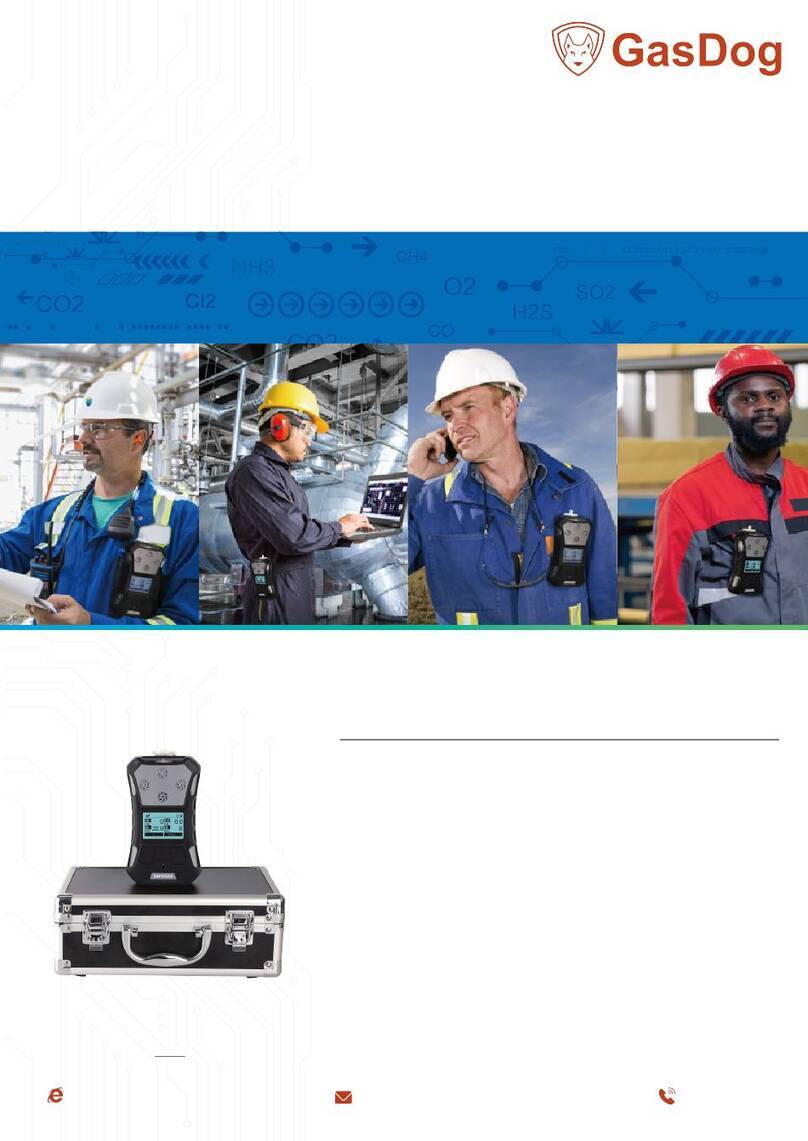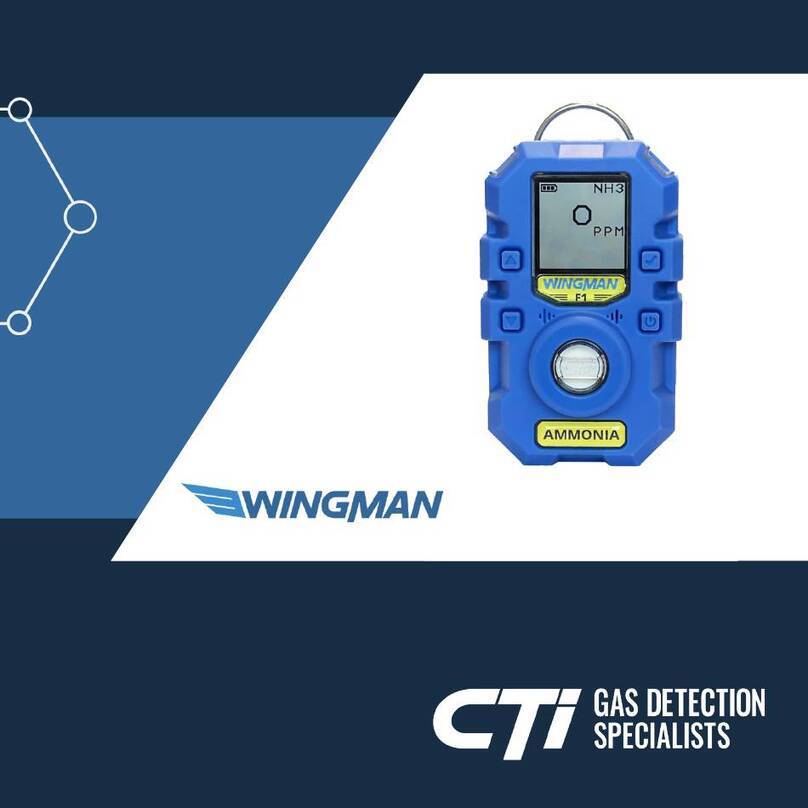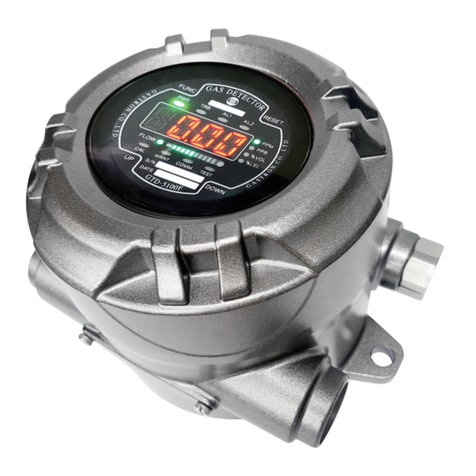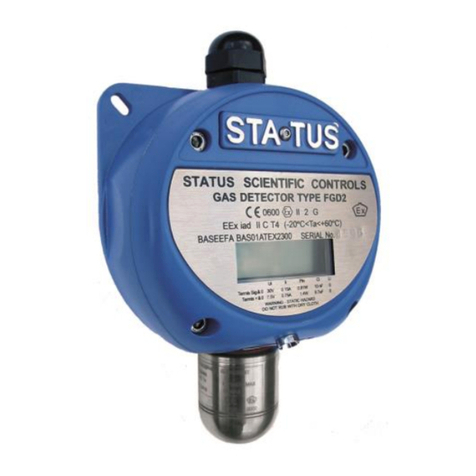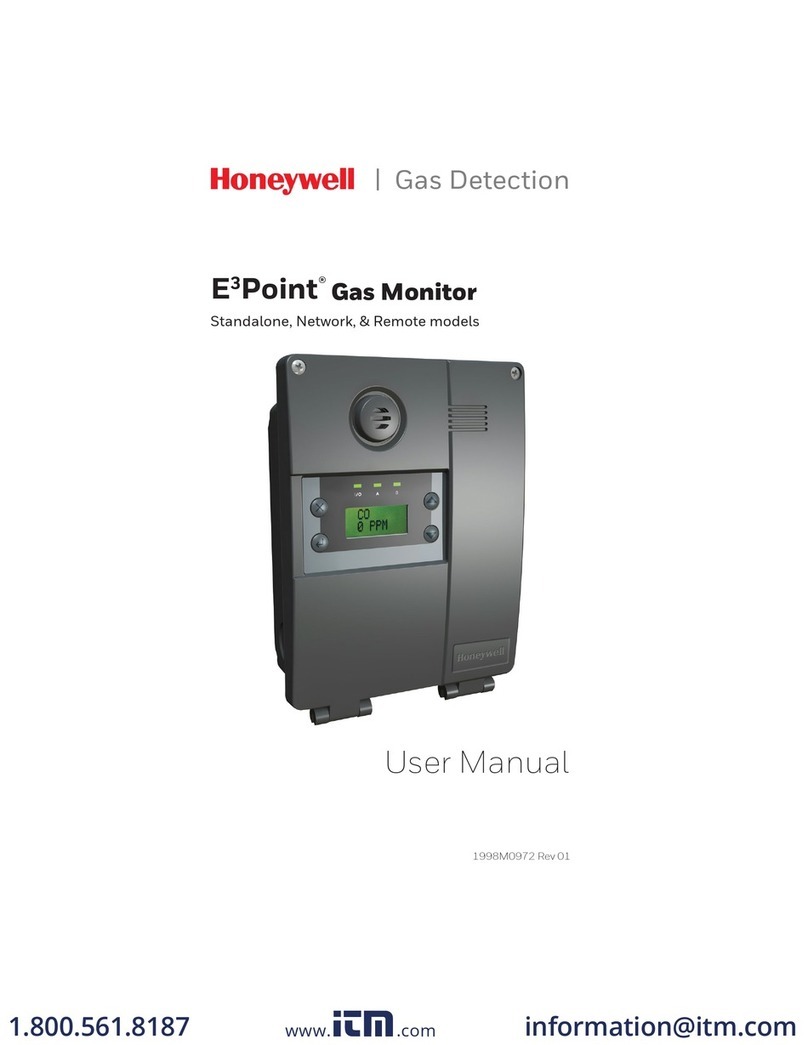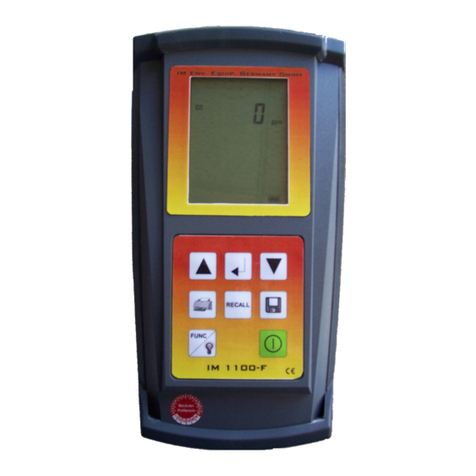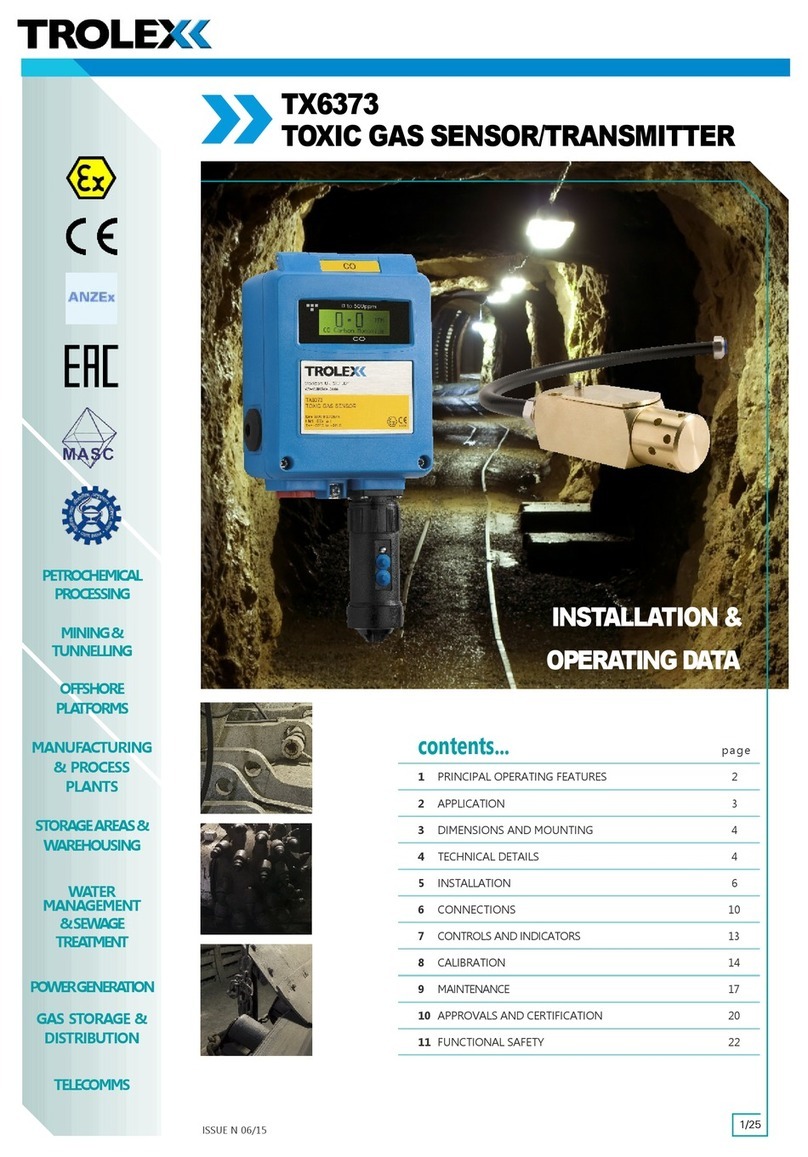General Monitors TS4000H Use and care manual

TS4000H HART
HART Communication Manual
The information and technical data disclosed in
this document may be used and disseminated
only for the purposes and to the extent
specifically authorized in writing by General
Monitors.
Instruction Manual 05-09
General Monitors reserves the right to change
published specifications and designs without
prior notice.
MANTS4000HH
Part No. MANTS4000HH
Revision B/05-09

TS4000H HART
ii
Table of Contents
TABLE OF CONTENTS........................................................................................II
TABLE OF TABLES............................................................................................IV
1.0 INTRODUCTION.........................................................................................1
1.1 Scope........................................................................................................................1
1.2 Purpose ....................................................................................................................1
1.3 References ...............................................................................................................1
2.0 DEVICE IDENTIFICATION .........................................................................1
3.0 PRODUCT OVERVIEW ..............................................................................2
3.1 Getting Started..........................................................................................................2
4.0 PRODUCT INTERFACES...........................................................................3
4.1 Process Interface......................................................................................................3
4.2 Host Interface ...........................................................................................................3
4.3 Local Interfaces, Jumpers, and Switches.................................................................3
5.0 DEVICE VARIABLES .................................................................................3
6.0 DYNAMIC VARIABLES..............................................................................3
6.1 Primary Variable = Part Per Million...........................................................................3
6.2 Secondary, Tertiary, and Quaternary Variables: Not Applicable..............................3
7.0 STATUS INFORMATION............................................................................4
8.0 UNIVERSAL COMMANDS .........................................................................5
9.0 COMMON PRACTICE COMMANDS..........................................................5
9.1 Supported Commands..............................................................................................5
9.2 Burst Mode ...............................................................................................................5
9.3 Catch Device Variable..............................................................................................5
10.0 DEVICE SPECIFIC COMMANDS...............................................................6
10.1 Command #131: Do Abort........................................................................................6
10.2 Command #136: Set Alarm Level.............................................................................6
10.3 Command #137: Set Warn Level .............................................................................7
10.4 Command #139: Reset Alarm..................................................................................7
10.5 Command #141: Set Relay (Alarm) Configuration...................................................8
10.6 Command #142: Reset Event Happened Flag.........................................................9
10.7 Command #143: Read Event Logging Counters......................................................9
10.8 Command #144: Clear Event Logging Counters....................................................10
10.9 Command #145: Read Warning Event Log............................................................10
10.10 Command #146: Read Alarm Event Log................................................................11
10.11 Command #147: Read Fault Event Log.................................................................11
10.12 Command #148: Read Maintenance Event Log ....................................................12
10.13 Command #149: Set Clock.....................................................................................13

TS4000H HART
iii
10.14 Command #150: Read Clock .................................................................................13
10.15 Command #151: Set Run Time Meter....................................................................14
10.16 Command #152: Read Run Time Meter.................................................................14
10.17 Command #154: Set Event Index...........................................................................15
10.18 Command #155: Get Event Index..........................................................................15
10.19 Command #156: Read Calibration Event Log........................................................16
10.20 Command #163: Get Fast Changing Information...................................................16
10.21 Command #164: Get Slow Changing Information..................................................17
10.22 Command #165: Get Set Up Information...............................................................18
10.23 Command #170: Set Current Range......................................................................19
10.24 Command #185: Set Gas ID or sensor type...........................................................19
10.25 Command #189: Set Sensor Life ...........................................................................20
10.26 Command #192: Do Calibration.............................................................................20
10.27 Command #195: Do Gas Check.............................................................................21
10.28 Command #196: Set Sensor Rang (Full Scale) .....................................................21
11.0 TABLES....................................................................................................22
11.1 TS4000H – Device Specific Commands Summary................................................22
11.2 TS4000H – Operating Mode - PV Values...............................................................23
11.3 Fault Event Log – Cause Description.....................................................................23
11.4 Sensor Type (ID) – Description ..............................................................................24
12.0 PERFORMANCE ......................................................................................25
12.1 Sampling Rates ......................................................................................................25
12.2 Power-up ................................................................................................................25
12.3 Device Reset ..........................................................................................................25
12.4 Self-Test .................................................................................................................25
12.5 Command Response Delay....................................................................................25
12.6 Busy and Delayed-Response.................................................................................25
12.7 Long Messages ......................................................................................................25
12.8 Non-Volatile Memory..............................................................................................25
12.9 Operating Modes....................................................................................................25
12.10 Write Protection......................................................................................................26
ANNEX A. CAPABILITY CHECKLIST...............................................................26
ANNEX B. DEFAULT CONFIGURATION..........................................................27
ANNEX C. DEVICE DESCRIPTOR LANGUAGE MENU...................................28

TS4000H HART
iv
Table of Tables
Table 1: Field Device Identification Data ......................................................................................1
Table 2: Error Status Information..................................................................................................4
Table 3: TS4000H – Common Practice Commands.....................................................................5
Table 4: TS4000H – Device Specific Commands.......................................................................22
Table 5: TS4000H - Operating Mode - PV Values.....................................................................23
Table 6: Fault Event Log – Cause Description ...........................................................................23
Table 7: Sensor Type (ID) – Description.....................................................................................24
Table 8: Command Response Times .........................................................................................25
Table 9: Capability Checklist.......................................................................................................26
Table 10: Default Configuration..................................................................................................27

TS4000H HART
1
1.0 Introduction
1.1 Scope
The TS4000H HART toxic gas detector complies with HART Protocol Revision 6.0. This
document specifies all of the device specific features and documents HART Protocol
implementation details. The functionality of this Field Device is described sufficiently to allow its
proper application in a process and its complete support in HART capable Host Applications.
1.2 Purpose
This specification is designed to complement the TS4000H Instruction Manual by providing a
complete description of this field device from a HART Communications perspective. This
specification is designed to be a technical reference for HART capable host application
developers, system integrators, and knowledgeable end users.
1.3 References
DOCUMENT NAME DOCUMENT RELATIONSHIP
HART Communications Protocol
Specifications This is used to insure compliance with the HART
Communication Protocol.
TS4000H Instruction Manual This is the General Monitors TS4000H Product
Instruction Manual.
2.0 Device Identification
The following Table 1 is the Field Device Identification Data for the instrument.
Manufacturer’s
Name General
Monitors, Inc. Model Number TS4000H
HART ID Code 223 (DF Hex) Device Type Code: 137 (89 Hex)
HART Protocol
Revision 6.0 Device Revision: 1
Number of
Device Variables 0
Physical Layers
Supported 1
Physical Device
Category FSK
Table 1: Field Device Identification Data

TS4000H HART
3.0 Product Overview
The TS4000H is an intelligent sensor for the detection of toxic gas and vapors. The
microprocessor-based electronics processes information at the sensor site, within an explosion-
proof housing. The TS4000H accurately measures toxic gas and reports the measurement as a
parts per million (ppm) of the gas.
3.1 Getting Started
In order to enable HART communication with the TS4000H detector, users may employ several
means including HART handheld communicators or PC-based systems. Using a PC-based
software application and a HART interface modem, for example, allow operators to access
information from the TS4000H. A typical setup is illustrated in Figure 1.
2
PLC
Or
HART
Modem Power
Supply
250
Ohm
375 HandHelded
+24
Analog Output
Figure 1: Connecting a PC to a HART device
Once the detector is installed (see TS4000H Instruction Manual) and connected to a PC, host
application, or handheld terminal, the master will commonly begin communication to
the TS4000H by using the HART Command #0. The field device will then respond only if its
tag matches. The data in the reply to Command #11 is identical to that of Command #0, so the
master can then construct the Unique Identifier for use with further commands.
NOTE: The handheld device allows for the retrieval of diagnostic information and input of
device settings as needed and should not be used as a permanent part of a safety
system.

TS4000H HART
3
4.0 Product Interfaces
4.1 Process Interface
This section describes all interfaces between the devices and the measured process.
4.1.1 Sensor Input Channels
A digital display provides indications and display codes that can be viewed through a window in
the cover. A red LED above the digital display signifies an ALARM condition, while a red LED
below the digital display signifies a WARN condition. Analog signal (4-20 mA) and relays
provide remote and/or discrete indications of the sensor’s operation.
4.2 Host Interface
The HART interface uses the 4 – 20 mA current loop. Refer to the installation manual for
connection details.
4.2.1 Analog Output: TS4000H Mode
The primary variable is proportional to the part per million. 4.0 mA output current corresponds
to 0 ppm. 20.0 mA output current corresponds to 100 ppm or 100% of full scale.
4.3 Local Interfaces, Jumpers, and Switches
4.3.1 Local Controls And Displays
Refer to the Installation Manual for connection details.
4.3.2 Internal Jumpers And Switches
Refer to the Installation Manual for connection details.
5.0 Device Variables
There are no device variables exposed to the user.
6.0 Dynamic Variables
There is only one Dynamic Variable exposed to the user.
6.1 Primary Variable = Part Per Million
The primary variable is proportional to the part per million 4.0 mA output current corresponds to
0 ppm. 20.0 mA output current corresponds to 100 ppm or 100% of full scale. The device mode
is the variable, which corresponds to the Modbus register 0x00.
6.2 Secondary, Tertiary, and Quaternary Variables: Not Applicable
There are none defined for the TS4000H product.

TS4000H HART
4
7.0 Status Information
The error status, which is returned via Common Practice Command #48, is shown in Table 2
and corresponds to Modbus register 0x02.
Byte Bit Description Class Device Status
Bits Set
0 Switch Error Error 4,7
1 Internal error (2.5,15V) Error 4,7
2 Not Used Error 4,7
3 Not Used Error 4,7
4 Not Used Error 4,7
5 Fault Status 4,7
6 Warning Status 4,7
1
7 Alarm Status 4,7
0 Not Used N/A
1 Low Supply Voltage Error 4,7
2 Fail to Calibrate Error 4,7
3 Sensor Error Error 4,7
4 Flash Error Error 4,7
5 EEPROM Error Error 4,7
6 Calibration Check Time out Error 4,7
0
7 Set up Error Error 4,7
Table 2: Error Status Information
These bits may be set at power-up to indicate an instrument failure. They may also be set by a
failure detected during continuous background diagnostic testing.

TS4000H HART
5
8.0 Universal Commands
Command 3 returns the current loop variable and the primary variable for a total of 9 bytes
returned. Command 9 returns the PV only.
9.0 Common Practice Commands
The following common practice commands are implemented.
9.1 Supported Commands
The following common-practice commands shown in Table 3 are implemented:
Command Number Byte
Number Meaning
Command 38 N/A Reset Configuration Changed Flag
Command 48 0 Returns Priority Fault, High Byte
Command 48 1 Returns Priority Fault, Low Byte
Command 48 2 Returns Error Status (same as Modbus register x02),
High Byte
Command 48 3 Returns Error Status (same as Modbus register x02),
Low Byte
Command 48 4 Returns Power Cycled Flag
Command 48 5 Returns Event Happened Flag
Command 48 6 Returns 0x01 = “Maintenance Required” or 0x02 =
Alarm or Warning
Command 48 7 Returns 0
Table 3: TS4000H – Common Practice Commands
9.2 Burst Mode
The TS4000H does not support Burst Mode.
9.3 Catch Device Variable
This TS4000H does not support Catch Device Variable.

TS4000H HART
6
10.0 Device Specific Commands
The Device Specific commands are used strictly for the unique features of the TS4000H and at
the discretion of General Monitors. They are described here in Section 10.0 and are
summarized in Table 4.
10.1 Command #131: Do Abort
This command aborts calibration or gas check.
Request Data Bytes
Byte Format Description
None N/A N/A
Response Data Bytes
Byte Format Description
0 N/A N/A
Command-Specific Response Codes
Code Class Description
0 Success No Command-Specific Errors
1 - 15 Undefined
16 Error Access Restricted
17 - 127 Undefined
10.2 Command #136: Set Alarm Level
This command sets the Alarm level.
Request Data Bytes
Byte Format Description
0 Unsigned-8 Alarm level, % of FS
Response Data Bytes
Byte Format Description
0 Unsigned-8 Alarm level, % of FS
Command-Specific Response Codes
Code Class Description
0 Success No Command-Specific Errors
1 – 2 N/A Undefined
3 Error Passed Parameter Too Large
4 N/A Undefined
5 Error Too Few Data Bytes Received

TS4000H HART
7
Code Class Description
6 – 15 N/A Undefined
16 Error Access Restricted
17 – 127 N/A Undefined
10.3 Command #137: Set Warn Level
This command sets the Warn level.
Request Data Bytes
Byte Format Description
0 Unsigned-8 Alarm Warn level, % of FS
Response Data Bytes
Byte Format Description
0 Unsigned-8 Alarm Warn level, % of FS
Command-Specific Response Codes
Code Class Description
0 Success No Command-Specific Errors
1 – 2 N/A Undefined
3 Error Passed Parameter Too Large
4 N/A Undefined
5 Error Too Few Data Bytes Received
6 – 15 N/A Undefined
16 Error Access Restricted
17 – 127 N/A Undefined
10.4 Command #139: Reset Alarm
This command resets the latching Warn and Alarm relay.
Request Data Bytes
Byte Format Description
None N/A N/A
Response Data Bytes
Byte Format Description
None N/A N/A
Command-Specific Response Codes
Code Class Description
0 Success No Command-Specific Errors

TS4000H HART
8
Code Class Description
1 - 15 Undefined
16 Error Access Restricted
17 - 127 Undefined
10.5 Command #141: Set Relay (Alarm) Configuration
This command configures the relay settings.
Request Data Bytes
Byte Format Description
0 Unsigned-8 Alarm Hi Relay La/nL: 0 – nL, 1 – LA
1 Unsigned-8 Alarm Hi Relay En/dE: 0 – dE, 1 – En
2 Unsigned-8 Alarm Lo Relay La/nL: 0 – nL, 1 – LA
3 Unsigned-8 Alarm Lo Relay En/dE: 0 – dE, 1 – En
Response Data Bytes
Byte Format Description
0 Unsigned-8 Alarm Hi Relay La/nL: 0 – nL, 1 – LA
1 Unsigned-8 Alarm Hi Relay En/dE: 0 – dE, 1 – En
2 Unsigned-8 Alarm Lo Relay La/nL: 0 – nL, 1 – LA
3 Unsigned-8 Alarm Lo Relay En/dE: 0 – dE, 1 – En
Command-Specific Response Codes
Code Class Description
0 Success No Command-Specific Errors
1 - 2 Undefined
3 Error Passed Parameter too large
4 Undefined
5 Error Too Few Data Bytes Received
16 Error Access Restricted
17 – 127 Undefined

TS4000H HART
9
10.6 Command #142: Reset Event Happened Flag
This command resets the Event Happened Flag.
Request Data Bytes
Byte Format Description
None N/A N/A
Response Data Bytes
Byte Format Description
None N/A N/A
Command-Specific Response Codes
Code Class Description
0 Success No Command-Specific Errors
1 – 15 Undefined
16 Error Access Restricted
17 – 127 Undefined
10.7 Command #143: Read Event Logging Counters
This command reads five event logging counters.
Request Data Bytes
Byte Format Description
None N/A N/A
Response Data Bytes
Byte Format Description
0 – 1 Unsigned-16 Warning Event Counter
2 – 3 Unsigned-16 Alarm Event Counter
4 – 5 Unsigned-16 Fault Event Counter
6 – 7 Unsigned-16 Maintenance Event Counter
8 – 9 Unsigned-16 Calibrate Event Counter
Command-Specific Response Codes
Code Class Description
0 Success No Command-Specific Errors
1-127 Undefined

TS4000H HART
10
10.8 Command #144: Clear Event Logging Counters
This command resets the 5 event logging counters to zero.
Request Data Bytes
Byte Format Description
None N/A N/A
Response Data Bytes
Byte Format Description
None N/A N/A
Command-Specific Response Codes
Code Class Description
0 Success No Command-Specific Errors
1-127 Undefined
10.9 Command #145: Read Warning Event Log
This command reads the Warning Event Log as specified by the event log number. Event 0 is
the most recent event. Event 1 is the one just before that and so forth.
Request Data Bytes
Byte Format Description
None N/A N/A
Response Data Bytes
Byte Format Description
0 – 3 Unsigned-32 Event Running Time (in Seconds)
4– 6 Date Event Date: Day, Month, Year – 1900
7 Unsigned-8 Event Hour
8 Unsigned-8 Event Minute
9 Unsigned-8 Event Second
10-13 Unsigned-8 Reserved = 0
Command-Specific Response Codes
Code Class Description
0 Success No Command-Specific Errors
1-127 Undefined

TS4000H HART
11
10.10 Command #146: Read Alarm Event Log
This command reads the Alarm Event Log as specified by the event log number. Event 0 is the
most recent event. Event 1 is the one just before that and so forth.
Request Data Bytes
Byte Format Description
None N/A N/A
Response Data Bytes
Byte Format Description
0 – 3 Unsigned-32 Event Running Time (in Seconds)
4– 6 Date Event Date: Day, Month, Year – 1900
7 Unsigned-8 Event Hour
8 Unsigned-8 Event Minute
9 Unsigned-8 Event Second
10-13 Unsigned-8 Reserved = 0
Command-Specific Response Codes
Code Class Description
0 Success No Command-Specific Errors
1-127 Undefined
10.11 Command #147: Read Fault Event Log
This command reads the Fault Event Log as specified by the event log number. Event 0 is the
most recent event. Event 1 is the one just before that and so forth.
Request Data Bytes
Byte Format Description
None N/A N/A
Response Data Bytes
Byte Format Description
0 – 3 Unsigned-32 Event Running Time (in Seconds)
4– 6 Date Event Date: Day, Month, Year – 1900
7 Unsigned-8 Event Hour
8 Unsigned-8 Event Minute
9 Unsigned-8 Event Second
10-11 Unsigned-16 Event Cause – See device specific table

TS4000H HART
12
Command-Specific Response Codes
Code Class Description
0 Success No Command-Specific Errors
1-127 Undefined
10.12 Command #148: Read Maintenance Event Log
This command reads the Maintenance Event Log as specified by the event log number. Event
0 is the most recent event. Event 1 is the one just before that and so forth.
Request Data Bytes
Byte Format Description
None N/A N/A
Response Data Bytes
Byte Format Description
0 Unsigned-8 Event Log Number
0 – 3 Unsigned-32 Event Running Time (in Seconds)
4– 6 Date Event Date: Day, Month, Year – 1900
7 Unsigned-8 Event Hour
8 Unsigned-8 Event Minute
9 Unsigned-8 Event Second
10-11 Unsigned-8 Reserved = 0
12-13 Unsigned-8 Code: 0-Gas check
Command-Specific Response Codes
Code Class Description
0 Success No Command-Specific Errors
1-127 Undefined

TS4000H HART
13
10.13 Command #149: Set Clock
This command sets the internal real-time clock.
Request Data Bytes
Byte Format Description
0 – 2 Date Date: Day, Month, Year-1900
3 Unsigned-8 Hours
4 Unsigned-8 Minutes
5 Unsigned-8 Seconds
Response Data Bytes
Byte Format Description
0 – 2 Date Date: Day, Month, Year-1900
3 Unsigned-8 Hours
4 Unsigned-8 Minutes
5 Unsigned-8 Seconds
Command-Specific Response Codes
Code Class Description
0 Success No Command-Specific Errors
1 – 4 Undefined
5 Error Too Few Data Bytes Received
6 – 127 Undefined
10.14 Command #150: Read Clock
This command reads the internal real-time clock setting.
Request Data Bytes
Byte Format Description
0 N/A N/A
Response Data Bytes
Byte Format Description
0 – 2 Date Date: Day, Month, Year-1900
3 Unsigned-8 Hours
4 Unsigned-8 Minutes
5 Unsigned-8 Seconds

TS4000H HART
14
Command-Specific Response Codes
Code Class Description
0 Success No Command-Specific Errors
1-127 Undefined
10.15 Command #151: Set Run Time Meter
This command sets the internal run time meter.
Request Data Bytes
Byte Format Description
0 – 3 Unsigned-32 Run Time Meter Value
Response Data Bytes
Byte Format Description
0 – 3 Unsigned-32 Run Time Meter Value
Command-Specific Response Codes
Code Class Description
0 Success No Command-Specific Errors
1 – 4 Undefined
5 Error Too Few Data Bytes Received
6 – 127 Undefined
10.16 Command #152: Read Run Time Meter
This command reads the internal run time meter.
Request Data Bytes
Byte Format Description
0 N/A N/A
Response Data Bytes
Byte Format Description
0 – 3 Unsigned-32 Run Time Meter Value
Command-Specific Response Codes
Code Class Description
0 Success No Command-Specific Errors
1-127 Undefined

TS4000H HART
15
10.17 Command #154: Set Event Index
This command sets the index of logged event to read. 0 – latest event
Request Data Bytes
Byte Format Description
0 Unsigned – 8 Sets index of logged event to read using commands 143 –
146. Range 0 – 9.
Response Data Bytes
Byte Format Description
0 Unsigned – 8 Event Index
Command-Specific Response Codes
Code Class Description
0 Success No Command-Specific Errors
1 – 2 Undefined
3 Error Passed Parameter Too Large
4 Undefined
5 Error Too Few Data Bytes Received
6 – 127 Undefined
10.18 Command #155: Get Event Index
This command reads the event logged index.
Request Data Bytes
Byte Format Description
None N/A N/A
Response Data Bytes
Byte Format Description
0 Unsigned – 8 Event index
Command-Specific Response Codes
Code Class Description
0 Success No Command-Specific Errors
1-127 Undefined

TS4000H HART
16
10.19 Command #156: Read Calibration Event Log
This command reads the Calibration Event Log as specified by the event log number. Event 0
is the most recent event. Event 1 is the one just before that and so forth.
Request Data Bytes
Byte Format Description
None N/A N/A
Response Data Bytes
Byte Format Description
0-3 Unsigned-32 Event Running Time (in Seconds)
4-6 Date Event Date: Day, Month, Year – 1900
7 Unsigned-8 Event Hour
8 Unsigned-8 Event Minute
9 Unsigned-8 Event Second
10 Unsigned-8 1 - N/A, 2 – Calibration
Command-Specific Response Codes
Code Class Description
0 Success No Command-Specific Errors
1-127 Undefined
10.20 Command #163: Get Fast Changing Information
This command reads the Fault Event Log as specified by the event log number. Event 0 is the
most recent event. Event 1 is the one just before that and so forth.
Request Data Bytes
Byte Format Description
None N/A N/A
Response Data Bytes
Byte Format Description
0 – 1 Unsigned-16 Mode – depends on instrument
2 – 3 Unsigned-16 Sub Mode – depends on instrument
4 – 7 Float Analog Output
8 – 9 Unsigned-16 Priority Fault
10 – 11 Bit map Error Status
12 Unsigned-8 Alarm Hi status : 0 – off, 1 – on , 2 – accepted
Other manuals for TS4000H
1
Table of contents



